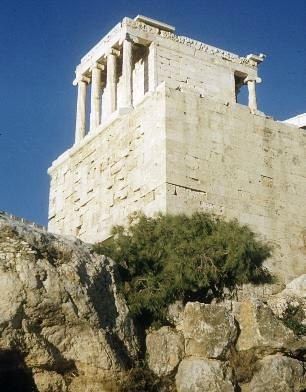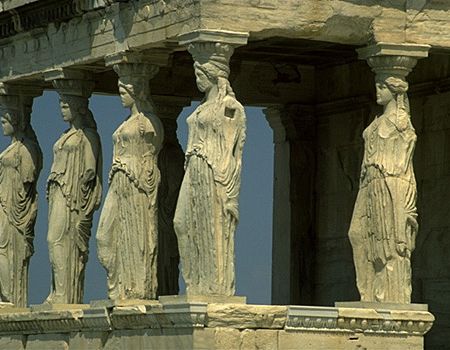Athens The Acropolis of Athens The Acropolis is the one historical site you can't miss. You can take a tour or wander up there yourself but during the summer, whatever you do, unless it is overcast, go early or late in the day. It can get very hot up there and gasping for breath can take way from your ability to marvel at the greatest of all archaeological sites. Getting to the Acropolis is easy and more pleasant than ever because the large avenues which border the south and west of the site (Apostolou Pavlou in Thission and Dionissiou Areopagitou in Makrianni) have been turned into giant pedestrian streets with cafes and restaurants and the walk is quite pleasant. From the Plaka and Monastiraki side it has always been a car-less, enjoyable walk and all you have to do is walk uphill from wherever you are and when you get to the top and there are woods instead of buildings, and steps, take a right. The main architect was Mnesicles, a colleague of Phidias. To your left is the Pinacotheca and a Hellenistic pedestal and on the right the tiny temple to Nike Athena or the Athena of Victory which commemorates the Athenians victory over the Persians. This small temple stands on a platform that overlooks the islands of Saronic Gulf and used to house a statue of Athena. It was dismantled by the Turks in 1686 so they could use the platform for a large cannon. It was rebuilt between 1836 and 1842 and again taken apart and rebuilt in 1936 when it was discovered that the platform was crumbing. If you looking from the propylaea towards Pireaus on a clear day you can see ships waiting outside the port of Pireaus, the islands and the mountains of the Peloponessos beyond. The Parthenon and other main buildings on the Acropolis were built by Pericles in the fifth century BC as a monument to the cultural and political achievements of the inhabitants of Athens. The term acropolis means upper city and many of the city states of ancient Greece are built around an acropolis where the inhabitants can go as a place of refuge in times of invasion. It's for this reason that the most sacred buildings are usually on the acropolis. It's the safest most secure place in town. As little as 150 years ago there were still dwellings on the Acropolis of Athens. Those of you who have read Aristophanes will recall that in Lysistrata the women have Athens barricaded themselves in the fortress in protest, being tired of their men going to war against Sparta. Nowdays there are still protests which occasionally take place by site employees closing the Acropolis to tourists, some of whom have waited a lifetime to come to Greece. Thankfully these are rare and of short duration. The best time to go up there is the late winter or spring when even this stone mountain is not immune to the proliferation of grass and wildflowers which seem to burst from every crack. Even in December, January and February the Acropolis can be surprisingly green. Below the Acropolis is the theater of Herod Atticus built by the Romans in 161 AD and still used today for classical concerts, ballet, performancesof high cultural value and Yanni. Further on is the Theater of Dionysious the first stone theater and home to Sophocles, Aeschylus, Euripides and Aristophanes. It was rebuilt around 342 BC by Lykourgos and then enlarged by the Romans to be used for gladiator fights. For many people, Greek island is simply a cycladic island with cubic whitewashed houses, a maze of tiny streets, small churches and chapels at every corner, crystal clear sea. Each island has to offer something different and each one has its own character, style, lifestyle, traditions and customs. |




































